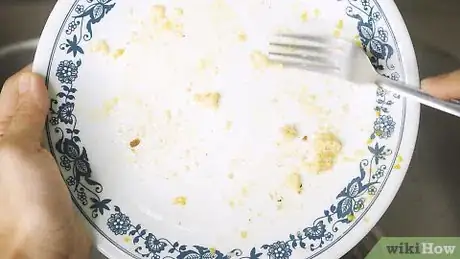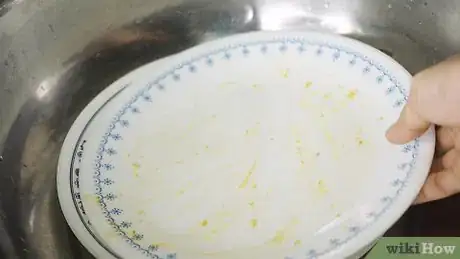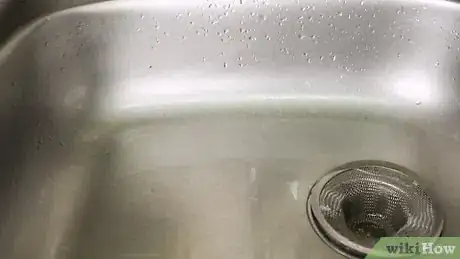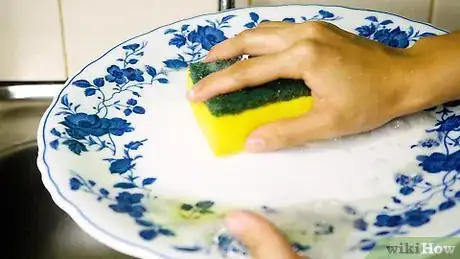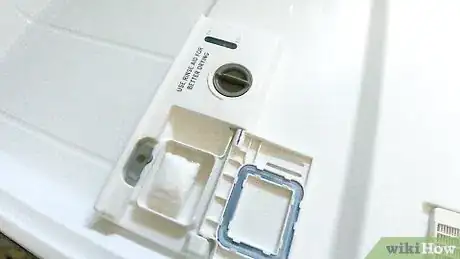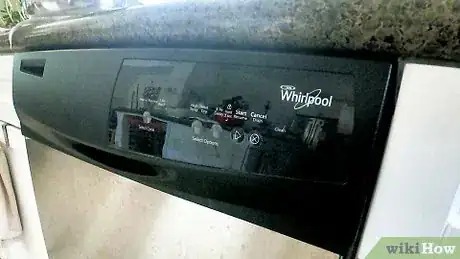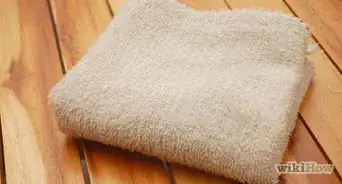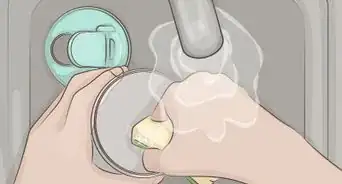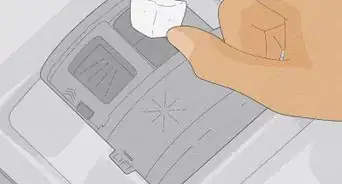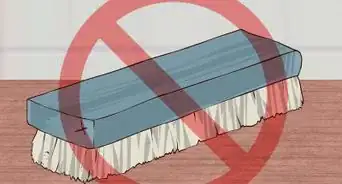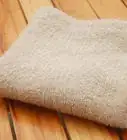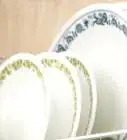This article was co-authored by Raymond Chiu and by wikiHow staff writer, Emily Liu. Raymond Chiu is the Director of Operations for MaidSailors.com, a residential and commercial cleaning service based in New York City that provides home and office cleaning services at affordable prices. He has a Bachelors in Business Administration and Management from Baruch College.
There are 13 references cited in this article, which can be found at the bottom of the page.
wikiHow marks an article as reader-approved once it receives enough positive feedback. In this case, several readers have written to tell us that this article was helpful to them, earning it our reader-approved status.
This article has been viewed 876,180 times.
Dishes can pile up quickly in your kitchen, but they're actually pretty easy to clean. Most dishes can be easily washed either by hand in the sink or by using a dishwasher, except for cast iron cookware. With a little time and effort, you'll soon have a stack of sparkly dishes!
Steps
Cleaning Dishes by Hand
-
1Fill your sink halfway with hot water and add 1 US tbsp (15 ml) of dish soap. Use the hottest water that you can handle putting your hands in! While the sink is filling up, pour 1 US tbsp (15 ml) of dish soap into the running water to create suds.[1]
- Make sure your sink is clean before washing your dishes.
-
2Scrape any leftover food into the trash or garbage disposal. Use your silverware to push any leftover food on your dishes into the trash can. This quickly clears your plate and makes washing it easier later on. If you have a garbage disposal, you can put any uneaten food down the drain while your disposal is running.[2]
- Don’t pour any grease down your drain since it could solidify and clog your pipes.
Advertisement -
3Work from lightly to heavily soiled dishes. Start by cleaning dishes such as utensils and drinking glasses. Then, move on to your plates and bowls. Lastly, soak and clean any pots, pans, or other cookware—leaving these for last is more effective since soaking loosens any stuck-on bits of food.[3]
-
4Scrub your dishes underwater with a sponge or dishcloth. Keep the dishes underwater as you wash them to loosen any stuck-on food. Using circular motions, wipe each dish clean with a sponge or a dishcloth. If any leftover food is still stuck afterward, scrub it off and wash any other spots you missed as well.[4]
- If the water gets too dirty to see through, drain your sink and refill it.
- Be careful when handling knives! To clean knives safely, wipe them clean from the back so you aren’t holding onto the blade. You should also never keep sharp knives in the sink since they may be hard to see if the water gets dirty.
- If your dishes have burnt-on food, soak them in your sink for 10-15 minutes before washing them.
- For stubborn stains on ceramic dishes, mix baking soda and vinegar to create a paste, then scrub the paste into the stains with a cloth. Rinse off the paste with warm water.[5]
- To clean a baking sheet with stuck-on food, mix baking soda and water to form a paste and scrub it into the food with a sponge. Add hydrogen peroxide to the mix for really stubborn stains.[6]
-
5Rinse off the soap with hot water. After you wash a dish, rinse it underneath the hottest water you can handle until the suds are gone. Make sure to rinse the inside of bowls and glasses a couple of times to ensure that all the suds are gone.[7]
- Avoid using cold water since it may cause water spots on your dishes.
- If you have a double sink, you can rinse off the suds on the second side to be more efficient. Otherwise, just alternate between washing and rinsing.
-
6Let the dishes dry on a rack or a clean towel. You can also dry them in the second side of a double sink. If you don’t have a drying rack, set the dishes upside down on a clean towel on your counter. Leave them to dry for 30-60 minutes.[8]
- It's safer and best to let your dishes air dry, since drying them with a dirty towel will only spread germs around more.
-
7Rinse off your sink after you put your dishes away. You don’t want any grease or food bits floating around the next time you need to use your sink. Run hot water and use a sponge or microfiber cloth with dish soap to wipe your sink down. Scrub longer if there are any areas with food stuck on. Work from the outside in, top to bottom, so that dirty water doesn’t drip into areas you’ve already cleaned.[9]
- Optionally, sprinkle some baking soda around the sink to break up any food particles before you begin.
- If your sink is really dirty, plug it and then fill it up with water. Add a capful of bleach and let it sit for 5 minutes before draining and wiping the sink down.[10]
- Make sure your sink is clear of any items before you begin cleaning it.
Loading a Dishwasher
-
1Get rid of any leftover food on your dishes and rinse them off. Scrape the food off of your plates or cookware into the garbage with your silverware to easily clear away the majority of it. Try to remove as much as you can so that it doesn’t clog your dishwasher. After you scrape the food from the dishes, rinse them in the sink to remove any smaller pieces that still may be stuck.[11]
- If you’re running your dishwasher immediately after you eat, you don’t need to rinse your dishes.
-
2Put cups, small bowls, and plastics on the top shelf of your dishwasher. Set the cups and bowls between the tines on the top rack of your dishwashers, and make sure they’re facedown or angled so that water doesn’t pool on them. Load from back to front so that you can fit more in.[12]
- Avoid nesting items, since this will prevent water from reaching and cleaning them.
- Plastics are loaded on the top shelf to prevent them from melting because the bottom of the dishwasher is hotter.
- Make sure all of your dishes say that they’re dishwasher-safe.
-
3Load plates, serving bowls, and other larger cookware on the bottom rack. Keep large flat pans and any other oversized items on the sides or the back of the bottom rack so that they don’t block the water spray. Stand your plates on their ends so that their dirty sides face the water sprayer and are cleaned more effectively. When you put in your pots and pans, make sure they’re upside down so that water doesn’t pool inside them.[13]
- Most dishwashers have angled tines on the bottom rack so that your plates will point in the right direction.
- Never stack your dishes on top of one another even if this seems more efficient, since the water in your dishwasher won’t be able to clean them all.
- Do not load cookware made of wood, pewter, cast iron, crystal, fine china, bronze, or brass.[14] [15]
-
4Put the utensils into the basket on the bottom rack or door. Make sure the handles face downwards so the dirty parts get cleaned. Leave space in between each utensil so the water can get in between the surfaces.[16]
- Mix spoons, forks, and knives so that they don’t nest together. Don't load sharp knives because the dishwasher can dull them, but duller knives like butter knives are okay to put in the dishwasher.
- Make sure long-handled utensils aren’t bumping into the water sprayer in the middle of your dishwasher. If they are, lay the utensils flat on the top rack instead.
- Separate silver and stainless steel cutlery since the silver may pit when they’re touching.
-
5Fill the designated compartment with a detergent made for use in a dishwasher. Check the instructions on your dishwasher to see how much to add, but usually 1 tablespoon (15 ml) of detergent will work. Alternatively, you can use detergent powder or cleaning pods inside your dishwasher.[17]
- Don’t use liquid dish soap, as this will leave a foamy residue on your dishes.
-
6Run the dishwasher. Close the dishwasher door, select the cycle you want to run, and press start. Let the dishwasher run until it’s completed.[18]
- The normal cycle on your machine will work fine for a regular wash.
- Use the delicate cycle if your dishes are lightly soiled or if you have fragile glassware in your dishwasher.
- Pick a heavy-duty cycle if you’re cleaning pots and pans.
- When unloading, empty the bottom rack first so that water from the top rack doesn’t spill down.[19]
Washing a Cast Iron Skillet
-
1Pour hot water into the skillet immediately after you’re done using it. Right after you remove the food from the cast iron skillet, fill the pan half-full with the hottest water you can handle. This will make it easier to scrape off food later. Leave the pan on the stovetop instead of putting it in the sink.[20]
- Pour the water into the skillet using a cup so you don’t have to carry it to your sink.
-
2Scrub off excess food with a new sponge or stiff-bristled brush. Hold onto the pan with an oven mitt or potholder using your non-dominant hand. Use your dominant hand to scrub any of the food that’s leftover from cooking immediately. Once the pan is clean, drain the water into your sink.[21]
- Don’t use detergent or steel wool on your pan since these can strip the pan.
- If the water is too hot, use a long-handled brush or hold the sponge with tongs.
- Don’t let the pan soak, or it could rust.
- If there’s still leftover food after draining, sprinkle in 2 tablespoons (18 grams) of coarse kosher salt and scrub away the remaining bits. The salt acts as an abrasive that helps remove the stuck food.[22]
-
3Dry the skillet on the stovetop. Leave your pan on the stove over low heat for 10-15 minutes, then remove it from the heat. Make sure to dry the entire pan so there’s no standing water or moisture left, or else your skillet could start to rust.[23]
-
4Rub vegetable oil into the skillet with a paper towel. Oiling your cast iron skillet helps keep it in good condition. Pour 1 tablespoon (15 ml) of vegetable oil into the skillet and rub the cooking surface with a paper towel to coat it. Work in small circles to buff the oil into the iron. Leave the oil to dry for 20-30 minutes before putting the skillet away.[24]
- If you don't have any vegetable oil, you can substitute 1 tablespoon (15 ml) of melted shortening instead.
Community Q&A
-
QuestionWhat should I do when my sink can't be filled with water?
 wikiHow Staff EditorThis answer was written by one of our trained team of researchers who validated it for accuracy and comprehensiveness.
wikiHow Staff EditorThis answer was written by one of our trained team of researchers who validated it for accuracy and comprehensiveness.
Staff Answer wikiHow Staff EditorStaff AnswerIn this instance, place a plastic bowl of a decent size into the sink. Try to use one with handles on each side for ease of lifting and carrying. This can contain the water from the faucet, and wash the dishes. To dispose of, lift it up and tip it down a laundry sink or the shower/bath drain. Since this will become tedious over time, look into getting your sink fixed so it can be filled with water again.
wikiHow Staff EditorStaff AnswerIn this instance, place a plastic bowl of a decent size into the sink. Try to use one with handles on each side for ease of lifting and carrying. This can contain the water from the faucet, and wash the dishes. To dispose of, lift it up and tip it down a laundry sink or the shower/bath drain. Since this will become tedious over time, look into getting your sink fixed so it can be filled with water again. -
QuestionI am 10. Why do you have to use hot water?
 wikiHow Staff EditorThis answer was written by one of our trained team of researchers who validated it for accuracy and comprehensiveness.
wikiHow Staff EditorThis answer was written by one of our trained team of researchers who validated it for accuracy and comprehensiveness.
Staff Answer wikiHow Staff EditorStaff AnswerHot water is usually the best way to get dishes clean because it helps break down the food particles that are stuck on the dishes. However, it is also easier to burn your hands and, in the case of starch-based foods, egg and milk stains, can actually set them. You can use lukewarm water, a good amount of quality hand washing dish detergent, a good quality scrubbing sponge and wear gloves to protect your hands if you're concerned about using hot water. Aim to make the water as warm as you can bear without being harmed by it, apart from the specific stains mentioned above.
wikiHow Staff EditorStaff AnswerHot water is usually the best way to get dishes clean because it helps break down the food particles that are stuck on the dishes. However, it is also easier to burn your hands and, in the case of starch-based foods, egg and milk stains, can actually set them. You can use lukewarm water, a good amount of quality hand washing dish detergent, a good quality scrubbing sponge and wear gloves to protect your hands if you're concerned about using hot water. Aim to make the water as warm as you can bear without being harmed by it, apart from the specific stains mentioned above. -
QuestionWhat if you don't have a dishwasher?
 wikiHow Staff EditorThis answer was written by one of our trained team of researchers who validated it for accuracy and comprehensiveness.
wikiHow Staff EditorThis answer was written by one of our trained team of researchers who validated it for accuracy and comprehensiveness.
Staff Answer wikiHow Staff EditorStaff AnswerWithout a dishwasher, you'll need to wash your dishes by hand. Hand washing is just as effective, it is more labor intensive. People have been washing dishes by hand for as long as people have had dishes though, so it's no big deal really!
wikiHow Staff EditorStaff AnswerWithout a dishwasher, you'll need to wash your dishes by hand. Hand washing is just as effective, it is more labor intensive. People have been washing dishes by hand for as long as people have had dishes though, so it's no big deal really!
Warnings
- Never leave sharp knives in the sink or else you may cut yourself.⧼thumbs_response⧽
Things You’ll Need
Cleaning Dishes by Hand
- Dish detergent
- Sponge or dishcloth
- Towel
- Drying rack
Loading a Dishwasher
- Dish detergent
Washing a Cast Iron Skillet
- Sponge or stiff-bristled brush
- Towel
- Oven mitt or potholder
- Paper towel
- Coarse kosher salt
- Vegetable oil
References
- ↑ https://www.cleaninginstitute.org/clean_living/hand_dishwashing_steps.aspx
- ↑ https://www.cleaninginstitute.org/clean_living/hand_dishwashing_steps.aspx
- ↑ https://www.cleaninginstitute.org/clean_living/hand_dishwashing_steps.aspx
- ↑ https://www.cleaninginstitute.org/clean_living/hand_dishwashing_steps.aspx
- ↑ Raymond Chiu. House Cleaning Professional. Expert Interview. 15 October 2019.
- ↑ Raymond Chiu. House Cleaning Professional. Expert Interview. 15 October 2019.
- ↑ https://www.cleaninginstitute.org/clean_living/hand_dishwashing_steps.aspx
- ↑ https://youtu.be/rzmOI7fTALY?t=105
- ↑ https://www.thekitchn.com/how-to-clean-your-kitchen-sink-249020
- ↑ https://www.thekitchn.com/the-one-thing-i-always-do-after-i-do-the-dishes-237655
- ↑ https://www.cleaninginstitute.org/clean_living/hand_dishwashing_steps.aspx
- ↑ https://www.bonappetit.com/story/loading-a-dishwasher
- ↑ https://www.consumerreports.org/dishwashers/how-to-load-a-dishwasher/
- ↑ https://youtu.be/krND0ASIYtQ?t=86
- ↑ https://www.consumerreports.org/dishwashers/how-to-load-a-dishwasher/
- ↑ https://www.bonappetit.com/story/loading-a-dishwasher
- ↑ https://www.cleaninginstitute.org/clean_living/dishwasher_faqs.aspx
- ↑ https://www.goodhousekeeping.com/appliances/dishwasher-reviews/a22031/dishwasher-tips-0306/
- ↑ https://www.consumerreports.org/dishwashers/how-to-load-a-dishwasher/
- ↑ https://www.thekitchn.com/how-to-clean-a-cast-iron-skillet-cleaning-lessons-from-the-kitchn-107747
- ↑ https://www.thekitchn.com/how-to-clean-a-cast-iron-skillet-cleaning-lessons-from-the-kitchn-107747
- ↑ https://www.thekitchn.com/skills-showdown-best-way-to-clean-cast-iron-skillets-23043250
- ↑ https://www.epicurious.com/expert-advice/how-to-wash-season-and-maintain-cast-iron-cookware-article
- ↑ https://www.thekitchn.com/how-to-clean-a-cast-iron-skillet-cleaning-lessons-from-the-kitchn-107747
About This Article
To wash dishes by hand, start by scraping any leftover food into the trash. Then, place the empty dishes in the sink, and fill the sink with hot water and dish soap. Next, use a sponge or dishcloth to scrub the dishes underwater, working on one dish at a time. When you're finished scrubbing a dish, double check it for any stuck-on food before rinsing it off with clean hot water. Finally, let your clean dishes air dry on a drying rack or clean towel. To learn how to load a dishwasher, scroll down!

